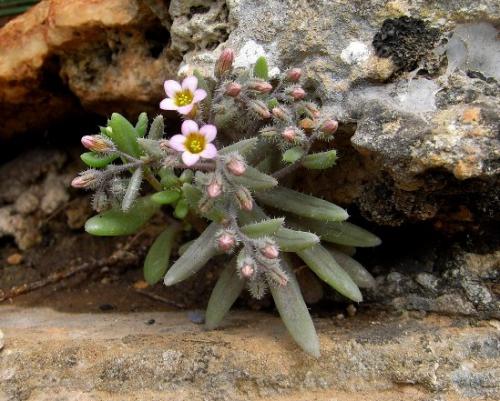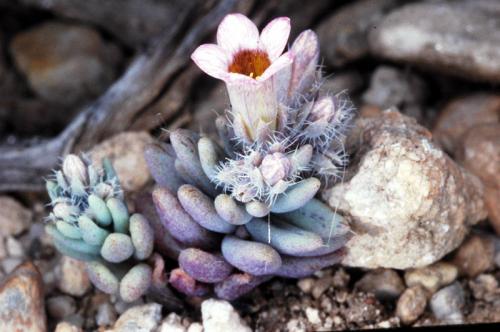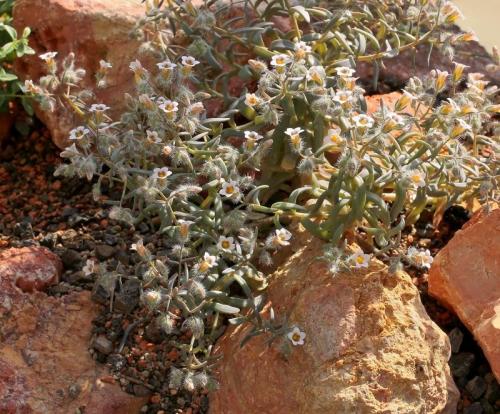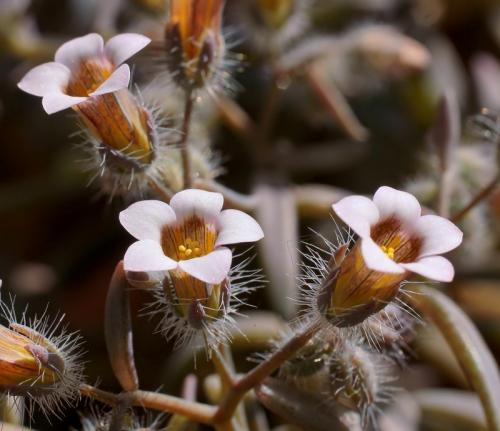MUCIZONIA (Ortega) Hamet, 1929
Synonyms :
Cotyledon mucizonia Ortega (1772)
Cotyledon hispida Lamarck (1786) / Umbilicus hispidus (Lamarck) DC (1828) / Cotyledon mucizonia var. hispida (Lamarck) Perez Lara (1891) / Mucizonia hispida (Lamarck) A.Berger (1930)
Cotyledon viscosa Vahl (1791)
Cotyledon mucizonia var. glabra Braun-Blanquet & Maire (1922) / Cotyledon mucizonia subvar. glabra (Braun-Blanquet & Maire) Maire (1932)
Cotyledon mucizonia var. eu-mucizonia Maire (1929)
Cotyledon mucizonia ssp. abylaea Font Quer & Maire (1931) / Mucizonia hispida ssp. abylaea (Font Quer & Maire) Greuter (1981) / Sedum mucizonia ssp. abylaeum (Font Quer & Maire) Springate (1996)
Cotyledon mucizonia subvar. glabella Font Quer & Maire (1931)
Cotyledon mucizonia subvar. villosa Font Quer & Maire (1931)
Cotyledon mucizonia ssp. ortegae Font Quer & Maire (1931)
Cotyledon mucizonia subvar. euhispida Maire (1932)
Sedum henriquesii A.Caballero (1949) / Mucizonia henriquesii (A.Caballero) Velayos & al. (1990)
Sedum mucizonia ssp. urceolatum R.Stephenson (1993)
Type : Ortega s.n., Spain ?
Etymology : Named for Mucio Zona, personal physician to Charles III of Spain.
Distribution : SW Europe (Portugal, Spain), N Africa (Algeria, Morocco).
Description (by 't Hart & Bleij in IHSP, 2003) :
Usually glandular-pubescent glaucous annual herbs with erect, often branched stems, to 15 (-20) cm tall.
Leaves alternate, sessile, subterete, elliptic to oblong or narrowly ovate, 7 - 18 (-20) x 2 - 5 (-8) mm, obtuse to rounded, sparsely glandular-pubescent or glabrous, glaucous-green.
Inflorescences lax glandular-pubescent cymes with 2 or more cincinni, bracts 1 per flower, pedicels 4 - 6 mm.
FIowers 5-merous, sepals broadly sessile, lanceolate, 1,5 - 5 mm, petals basally connate forming a tube 5,5 - 10 mm long, lobes ovate, 1,5 - 4 mm, acuminate, white or pink, often with purple veins, filaments basally connate with the corolla tube, white, anthers red or yellow.
Cytology: 2n = 16, 18,20,22.
Quite variable in size and shape of the leaves, pubescence, and flower shape and colour, but very distinct within the genus because of its sympetalous flowers. S. mucizonia is closely related to S. dasyphyllum and S. wilczekianum. It can be easily hybridized with the former, but the hybrids are completely sterile ('t Hart & al. 1999).
Ray Stephenson (Sedum, Cultivated Stonecrops, 1994, p 259) :
In spring, tight clusters of turgid, gray-green leaves hide stems. Sometimes by this stage, short bristles can be seen on leaves, but these become more apparent as stems elongate. Flower buds are exceptionally bristly, and distinctly tubed flowers are produced in summer. At first they appear white-pink, but throats soon flush yellow. Some forms of this species can act as perennials if treatment is perfect. By late summer, stems elongate and leaves shrivel, so plants are lax and soon desiccate.
Habitat : Southern Iberia, Algeria, and Morocco are the homes of this delightful stonecrop, from sea level to fairly high altitudes in the south, especially on rocky scree or solid lime-stone, in half-shaded nooks.
Main points of distinction : Branching only takes place at the very base of the plant. Bristles on buds, the hirsute nature of the stems, and tubed flowers are good indicators. Fusion of petals is the most easily observed feature. Fused for much more than half their length, they form a floral tube which is very pronounced.
Variation : Sometimes North African variations enter cultivation, but they tend not to be perpetuated.
Horticulture : Treat the species as an annual, but, as seed tends to germinate in autumn, either (1) allow self-seeding and remove the container from frosty conditions to overwinter in an alpine house, or (2) save the seed to sow in spring.
Observation au Maroc (Djebel Tahar) en mai 2011. Zones rocheuses non pâturées. Alt : env. 1000m.
Plant in habitat in Morocco (Djebel Tahar), May 2011. Rocky landscape, no pasturage, c. 1000m.



Sedum mucizonia, Frigiliana (Spain), Easter time.
Photos Ray Stephenson


Photos Stefan Neuwirth